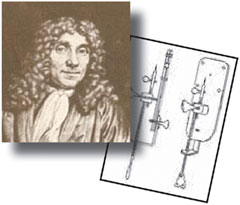Christiaan Huygens
(1629–1695)
Christiaan Huygens was a brilliant Dutch mathematician, physicist, and astronomer who lived during the seventeenth century, a period sometimes referred to as the Scientific Revolution. Huygens, a highly gifted theoretical and experimental scientist, is best known for his work on the theories of centrifugal force, the wave theory of light, and the pendulum clock.
At an early age, Huygens began work in advanced mathematics by attempting to disprove several theories established by the ancient Greeks in simple geometry. He was also very interested in astronomy and telescopes and spent a considerable amount of time devising methods to improve both the optical and mechanical performance of the telescope. His achievements in astronomy were reported in his 1659 book entitled Systema Saturnium in which he noted his discovery of the rings encircling the planet Saturn as well as his observations about the moon, the planets, and the Orion nebula.
Huygens’s keen interest in astronomy probably led to his efforts in the measurement of time and other matters relating to mechanical physics. He was heavily involved in a seventeenth-century controversy with Vincenzo Viviani as to the exact inventor of the pendulum clock, which he presented as an accomplishment of Dutch Science in his 1673 book Horologium Oscillatorium. This work may well have been one of Huygens’s finest efforts because he also suggested important principles of gravity in a vacuum, as well as many aspects of classical physics including centrifugal force.
During the middle seventeenth century, Huygens wrote a small treatise on the calculus of probabilities based on the theories of Pascal and Fermat and spent several years in England. His reputation as a scholar and scientist were becoming world renowned at this point, and he was offered a pension by French King Louis XIV to relocate to Paris. In France, Huygens’s work on timepieces progressed to the point of the inclusion of a balance spring to increase reliability and accuracy. The first watch using this principle was finished in 1675, whereupon it was promptly presented to his sponsor, King Louis XIV.
In 1681, Huygens returned to Holland where he began to construct optical lenses with extremely large focal lengths, which were eventually presented to the Royal Society of London, where they remain today. Continuing along this line of work, Huygens perfected his skills in lens grinding and subsequently invented the achromatic eyepiece that bears his name and is still in widespread use today.
Huygens left Holland in 1689, and ventured to London where he became acquainted with Sir Isaac Newton and began to study Newton’s theories on classical physics. Although it seems Huygens was duly impressed with Newton’s work, he was still very skeptical about any theory that did not explain gravitation by mechanical means.
In 1690 Huygens returned to Holland where he published a book started in 1687 on the physics of light entitled Traité de la Lumière, in which he suggested a theory to explain the wave-like nature of light. Huygens was unconvinced by the particle theory of light advanced by Newton, primarily because he thought the rapid speed of light would only be possible if light were composed of waves. He suggested that light waves traveled on an invisible “ether” that filled the void throughout air and space. In his famous “Huygens’ Principle,” he suggested that each point in a light wave could be explained by miniature wavelets that combined to form a wavefront. Huygens’s theories neatly explained the laws of refraction, diffraction, interference, and reflection, and he went on to make major advances in the theories concerning the phenomena of double refraction (birefringence) and polarization of light.
Huygens’s work in the fields of mathematics and physics led to significant steps forward in the advancement of science, particularly the fields of optics, astronomy, and mechanical physics.
Editor’s Note: See the original reference to Huygens’s essay in the Pioneers in Optics website https://micro.magnet.fsu.edu/optics/timeline/people/huygens.html , which includes an interactive Java tutorial, designed to illustrate the reflection and refraction of light according to the multiple wavelet concept.



